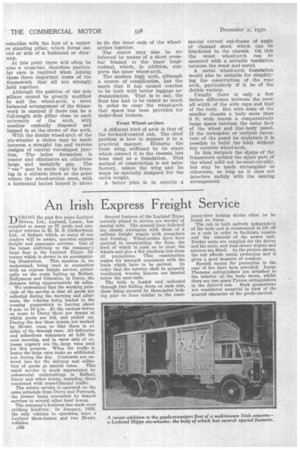An Irish Express Freight Service
Page 52

If you've noticed an error in this article please click here to report it so we can fix it.
DURING the past five years Leyland 1/Motors, Ltd., Leyland, Lancs., has supplied as many as 87 goods and passenger vehicles to H. M. S. Catherwood, Ltd., of Belfast; which, as many of our readers will be aware, operates express freight and passenger services. One of the latest additions to the company's large fleet is the Leyland Hippo 12tonner which is shown in an accompanying illustration. This machine is, we understand, being used in connection with an express freight service, principally on the route linking up Belfast, Ballymena and Coleraine, in Derry, the distance being approximately 84 miles.
We understand that the working principle of the service is that all goods are collected during the morning and afternoon, the vehicles being loaded in the evening preparatory to leaving about 9 p.m. or 10 p.m. At the various towns en route to Derry there are depots at which goods are left and picked up. During the day these depots are worked by 30-cwt. vans, so that there is no delay of the through vans. All deliveries and collections commence at 8.30 the next morning, and in cases only of extreme urgency are the, large vans used for this purpose. When the traffic is heavy the large vans make an additional run during the day. Contracts are entered into for the delivery and collec
tion of goods at special rates. This rapid service is much appreciated by commercial undertakings in Belfast, Derry and other towns, including those concerned with cross-Channel traffic.
The return service is operated on the same principle from Derry and Portrush, the former being connected by branch services to several other local towns.
The company's business has made most striking headway. In January, 1920, the only vehicles in operation were a Leyland three-tonner and two 30-cvrt. vehicles.
C30 Several features of the Leyland Hippo recently placed in service are worthy of special note. The general bees followed are closely analogous with those of a railway freight wagon with cross-bars and framing. Wheel-arches have been omitted in constructing the floor, the level of which is such as to clear the wheels and give a fiat platform free from all projections. This construction mates for strength consistent with the loads which have to be carried. In order that the interior shall be properly ventilated, wooden louvres are located below the cant-rails.
The body is loaded and unloaded through two folding doors on each side, these being secured by three-point locking gear on lines similar to the emer
gency-door locking device often to be found on buses.
The cab is built entirely independent of the body and is constructed to lift off as a unit in order to facilitate repairs and the removal of the power unit. Bucket seats are supplied for the driver and his mate, and dual screen wipers and mirrors are fitted. As the picture shows, the cab affords ample protection and it gives a good measure of comfort.
Special means for protection in the case of fire have been provided. Large Phomene extinguishers are attached to the interior of the body doors, whilst there are two Quart Pyreue extinguishers in the driver's. cab. Such precautions are considered essential in view of the general character of the goods.carried.












































































































